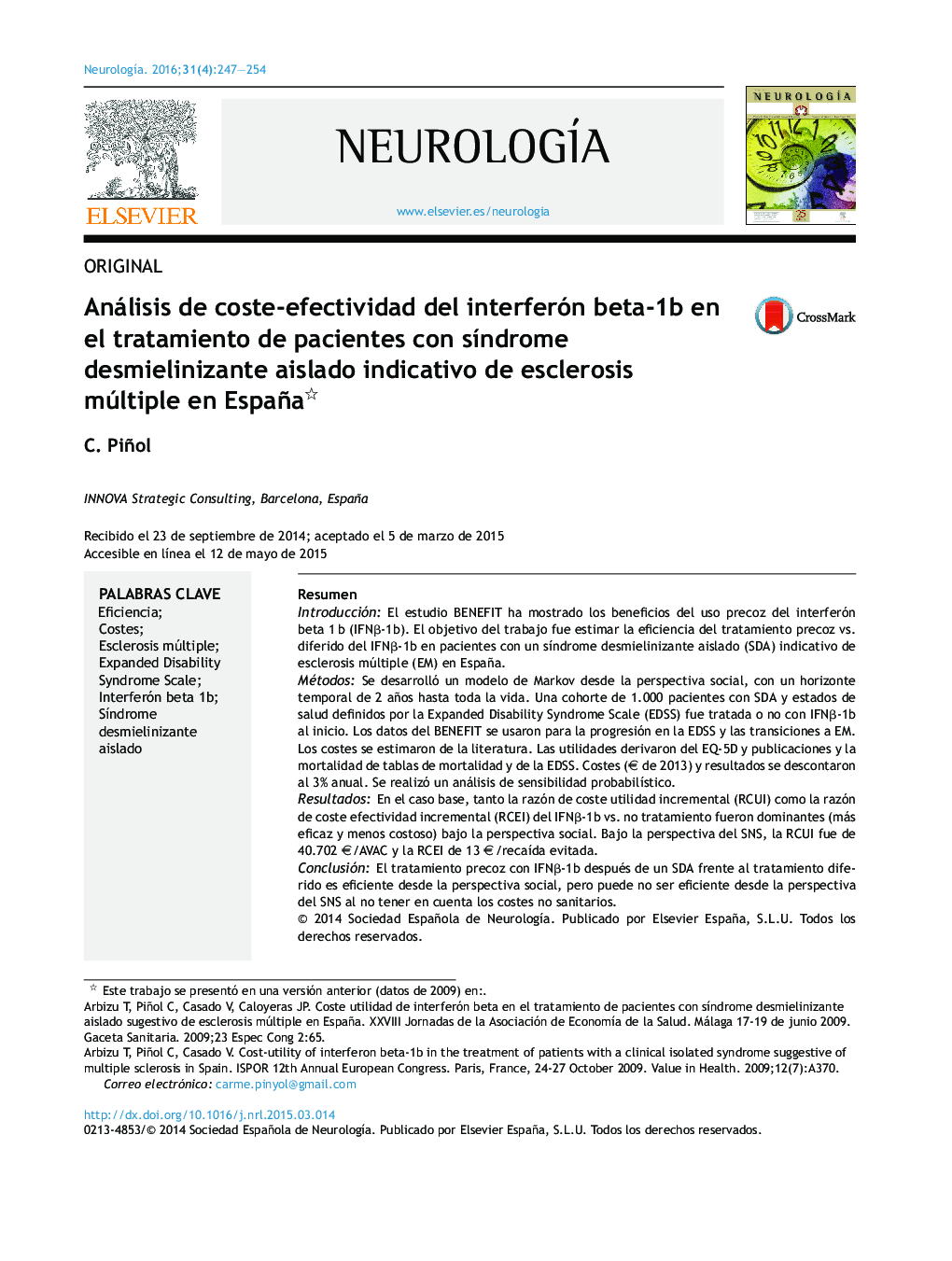| Article ID | Journal | Published Year | Pages | File Type |
|---|---|---|---|---|
| 3075689 | Neurología | 2016 | 8 Pages |
ResumenIntroducciónEl estudio BENEFIT ha mostrado los beneficios del uso precoz del interferón beta 1 b (IFNβ-1b). El objetivo del trabajo fue estimar la eficiencia del tratamiento precoz vs. diferido del IFNβ-1b en pacientes con un síndrome desmielinizante aislado (SDA) indicativo de esclerosis múltiple (EM) en España.MétodosSe desarrolló un modelo de Markov desde la perspectiva social, con un horizonte temporal de 2 años hasta toda la vida. Una cohorte de 1.000 pacientes con SDA y estados de salud definidos por la Expanded Disability Syndrome Scale (EDSS) fue tratada o no con IFNβ-1b al inicio. Los datos del BENEFIT se usaron para la progresión en la EDSS y las transiciones a EM. Los costes se estimaron de la literatura. Las utilidades derivaron del EQ-5D y publicaciones y la mortalidad de tablas de mortalidad y de la EDSS. Costes (€ de 2013) y resultados se descontaron al 3% anual. Se realizó un análisis de sensibilidad probabilístico.ResultadosEn el caso base, tanto la razón de coste utilidad incremental (RCUI) como la razón de coste efectividad incremental (RCEI) del IFNβ-1b vs. no tratamiento fueron dominantes (más eficaz y menos costoso) bajo la perspectiva social. Bajo la perspectiva del SNS, la RCUI fue de 40.702 €/AVAC y la RCEI de 13 €/recaída evitada.ConclusiónEl tratamiento precoz con IFNβ-1b después de un SDA frente al tratamiento diferido es eficiente desde la perspectiva social, pero puede no ser eficiente desde la perspectiva del SNS al no tener en cuenta los costes no sanitarios.
IntroductionThe BENEFIT study has demonstrated the benefits of early treatment with interferon beta 1 b (IFNβ-1b). The objective of this study was to estimate the efficiency of early vs delayed IFNβ-1b treatment in patients with clinically isolated syndrome (CIS) suggestive of multiple sclerosis (MS) in Spain.MethodsA Markov model reflecting the social perspective was developed with time horizons ranging from 2 years to lifetime. A cohort of 1000 patients with CIS, whose health status had been measured on the Expanded Disability Symptom Scale (EDSS), included patients who received early IFNβ-1b treatment and those who did not. Data from the BENEFIT study were used to model EDSS progression and transitions to MS. Costs were estimated from published literature. Patient utilities were derived from EQ-5D data and published data. Mortality was estimated using life tables and EDSS data. Costs (€ at 2013 rates) and outcomes were discounted at 3% per annum. A probabilistic sensitivity analysis was performed.ResultsIn the base case, both the incremental cost utility ratio (ICUR) and the incremental cost effectiveness ratio (ICER) of IFNβ-1b versus no treatment were dominant (more effective and less costly) from a social perspective. From the perspective of the Spanish Health System, the ICUR was € 40,702/QALY and the ICER was € 13/relapse avoided.ConclusionEarly treatment with IFNβ-1b after a CIS versus delayed treatment is efficient from a social perspective, but it may not be efficient from the perspective of the NHS which does not take non health-related costs into account
